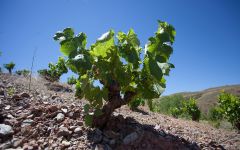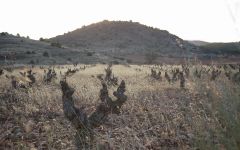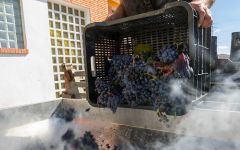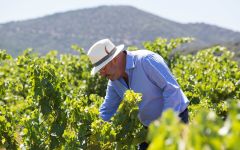Bodegas Breca Garnacha de Fuego 2020
- Vinous



Product Details
Your Rating
Somm Note
Winemaker Notes
Garnacha de Fuego is a young, primary fruit expression of the oldest clones of Garnacha in the world, from the high altitude mountains of Calatayud. The altitudes, age of the vines, and slate dominant soils produce a wine of tremendous character and concentration, balanced by fresh acidity that provides balance and drinkability, and elegant minerality.
Professional Ratings
-
Vinous
Neon ruby-red. Jammy red and blue fruit and floral aromas and flavors are sharpened by a spicy nuance that builds with air. Shows very good energy and refreshing tanginess on the long, subtly tannic finish, which leaves boysenberry, candied lavender and white pepper notes behind. The value here is ridiculous.
Other Vintages
2021-
Wilfred
Wong
-
Jeb
Dunnuck
-
Jeb
Dunnuck -
Wilfred
Wong
-
James
Suckling -
Jeb
Dunnuck
-
Robert
Parker
-
Robert
Parker









Located in the sleepy town of Munébrega, Bodegas Breca was founded by Jorge Ordóñez in 2010 with the mission of producing the finest Garnacha in Aragón. Garnacha de Aragón, the clone used to produce the wines of Bodegas Breca, is the most ancient and genetically untouched clone of Garnacha (Grenache) in the world. Garnacha was first cultivated in this northeastern corner of Spain and transplanted across the Mediterranean by the medieval Kingdom of Aragón, which had territories across the Mediterranean.
D.O. Calatayud has a unique, extreme terroir. The combination of radical altitudes, diverse slate soils, and drastic climate combine to create a completely unique mesoclimate. As Spain’s highest region to produce Garnacha, Calatayud frequently sees temperature swings of 45°F between day and night. In our mountainside vineyards (2600-3500ft.), our vines are oftentimes exposed to 40-100°F diurnal temperature swings in the summer. The heat allows the grapes to achieve full phenolic ripeness, and the cool nights build high acidity in the grapes. Due to its long vegetative cycle, Garnacha requires a relatively dry, hot climate to reach proper phenolic ripeness. The cold nights, dawn, and dusk, combined with a variety of slate dominant soils, allow the grapes to reach high levels of acidity. Our head trained vineyards were planted between 1900 and 1975, and as with all of the Grupo Jorge Ordóñez vineyards, they are dry farmed. These conditions produce exceptionally balanced wines with ageing potential due to their concentration and acidity.
Jorge Ordóñez pioneered the introduction of Garnacha into the United States in the 1990s, when Garnacha was the most widely planted grape in Spain. At the time, however, all the Spanish red wines available in the American market were Tempranillo dominant. Jorge recognized the quality of the old vine plantings of Garnacha and the wines they produced, and exposed the United States to these sensational wines.

Grenache thrives in any warm, Mediterranean climate where ample sunlight allows its clusters to achieve full phenolic ripeness. While Grenache's birthplace is Spain (there called Garnacha), today it is more recognized as the key player in the red blends of the Southern Rhône, namely Châteauneuf-du-Pape, Côtes du Rhône and its villages. Somm Secret—The Italian island of Sardinia produces bold, rustic, single varietal Grenache (there called Cannonau). California, Washington and Australia have achieved found success with Grenache, both flying solo and in blends.

Calatayud DO is a wine region tucked into northern Spain’s regions just south of Rioja, about 55 miles (90km) from the provincial capital, Zaragoza. When Calatayud attained DO status in the 90s, it rapidly became Aragon’s second largest quality wine-producing region after its neighbor, Cariñena. Since then, it has focused on upgrading and perfecting its wines with progressive improvements in both cooperatives and private bodegas. Similarly, there has been substantial investment in new technology, winemaking system, and vineyard research. Thanks to this, Calatayud wines are now beginning to show their true potential.
The principle red grape varieties grown are Garnacha Tinta, Tempranillo, Syrah, Bobal, Monastrell.
Many of the new wineries are exploring the potential of the Garnacha grape. A new category of red wines called Calatayud Superior is made from red Garnacha from low yield vines that are at least 50 years old.
The principal white grape varieties in Calatayud are Macabeo, Garnacha Blanca, Malvasía and Chardonnay.
